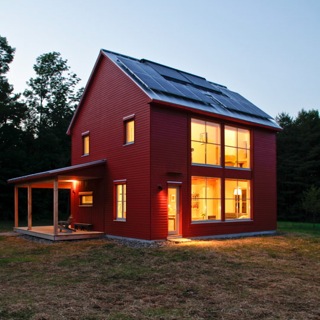
For the past several years, Still Water Co-Director Joline Blais has been working with two dozen other families to found Belfast Cohousing & Ecovillage. Now the prototype home for this self-developed, self-financed community on the coast of Maine has been declared 2011 Project of the Year by the US Green Building Council.
The USGBC is best known for its LEED (Leadership in Energy and Environmental Design) rating system. Green architects typically brag about their Silver, Gold, or Platinum LEED ratings, but the Belfast Cohousing & Ecovillage prototype has exceeded even those lofty standards. (Maybe the house should be rated Diamond—or Bamboo!)
In response to this news, noted eco-activist Bill McKibben told Joline Blais:
“Cohousing is to the suburb what the farmer’s market is to agribusiness: a powerful challenge reminding us that there are far sounder, and far more beautiful, ways to live our lives.”
Known as the GO Home, the prototype was built by G•O Logic architect Matt O’Malia and Belfast Cohousing member Alan Gibson. The award was presented at the 2011 Greenbuild International Conference & Expo in Toronto on October 6.
The USGBC represents 16,000 member companies and organizations and oversees the LEED (Leadership in Energy and Environmental Design) certifications for green buildings. The GO Home is rated LEED platinum (USGBC’s highest designation), and is Maine’s first Passive-House-Certified home, a 1500-square-foot elegant and functional model of the German Passive House Standard. The Passive House standard requires 86% improvement on a home’s space heating loads compared to the typically constructed home.
“The GO Home is on target to revolutionize the home construction standards in North America,” O’Malia said in an interview for Durability and Design. “This next generation of housing maximizes comfort, energy efficiency and cost while providing all the amenities of a standard home. The only thing a home owner needs to give up in this type of house is paying for heat.”
Following on the heels of last month’s Environmental Award from the National Resources Council of Maine, this fresh news rippled through the press:
“The designers were obsessive about capturing heat generated within the house—even the heat and moisture generated by the kitchen stove and laundry machines are captured and used to control the interior climate. In fact, the heat requirements for the building are so minimal, that to keep the structure at 70 degrees, even in the deepest, coldest winter night, takes the heat output of a hair dryer….One might expect such a structure to have huge building costs, but its construction costs were close to that of a conventional home—about $160 per square foot….The best news, perhaps, is that this home is the model for a 36-home co-housing development in Belfast, which is currently under construction.”
“Healthy, high performing residential projects don’t have to cost more, and that is evidenced in many of this year’s winning projects. LEED builders continue to push the envelope in areas of innovation and affordability, and so we tip our hats to the dedicated leaders represented in this year’s winners circle.”
— USGBC
“The big winner this year is GO Logic, a building company based in Belfast, Maine, that took home the 2011 Project of the Year award for its GO Home, a 1,500-sq.-ft. three-bedroom that qualified for LEED Platinum certification and Passivhaus certification—all for construction costs of about $160 per sq. ft.”
“Ultra efficient, affordable, and platinum.”

As designers and architects, we need to be conscious of practical and efficient construction materials and techniques. Sustainable design is now on everyone’s radar, so we need to go beyond it. We need to make sure that the building TYPES that we design are sustainable. Cohousing is one very good example of a building type that works for our modern lifestyles. We are having kids older, staying single, or becoming single, and leading very long lives. The single family home no longer works as an isolated castle. Cohousing allows people to maintain the privacy they cherish, while also having the option to be social and join a larger community at any time they please, something most if not all current housing types disregard or omit.
For a dose of good common design sense read Creating Cohousing: Building Sustainable Communities by Katie McCamant and Charles Durrett.
Pingback: Still Water blog · Making communities resilient with Joline Blais and gkisedtanamoogk